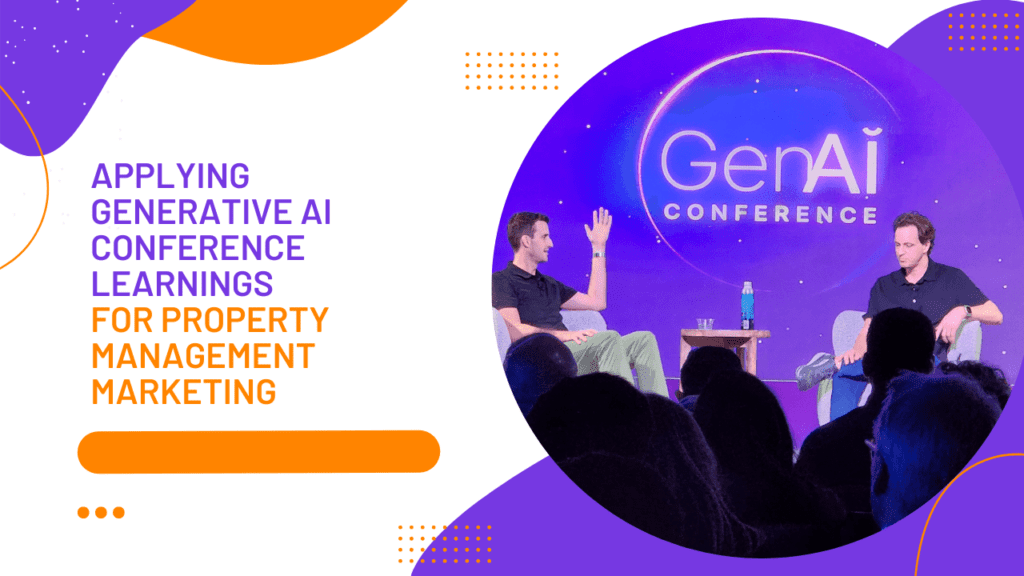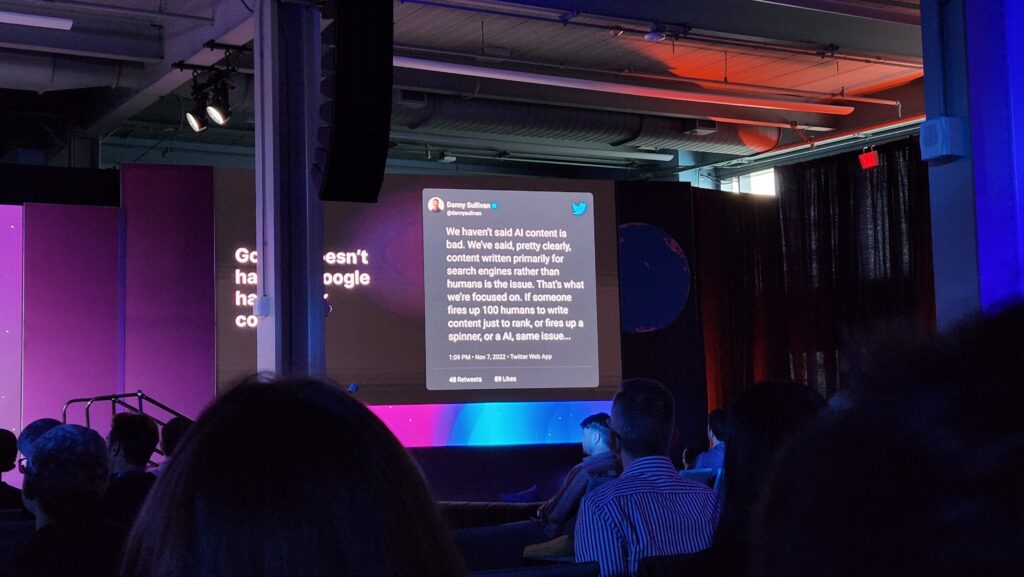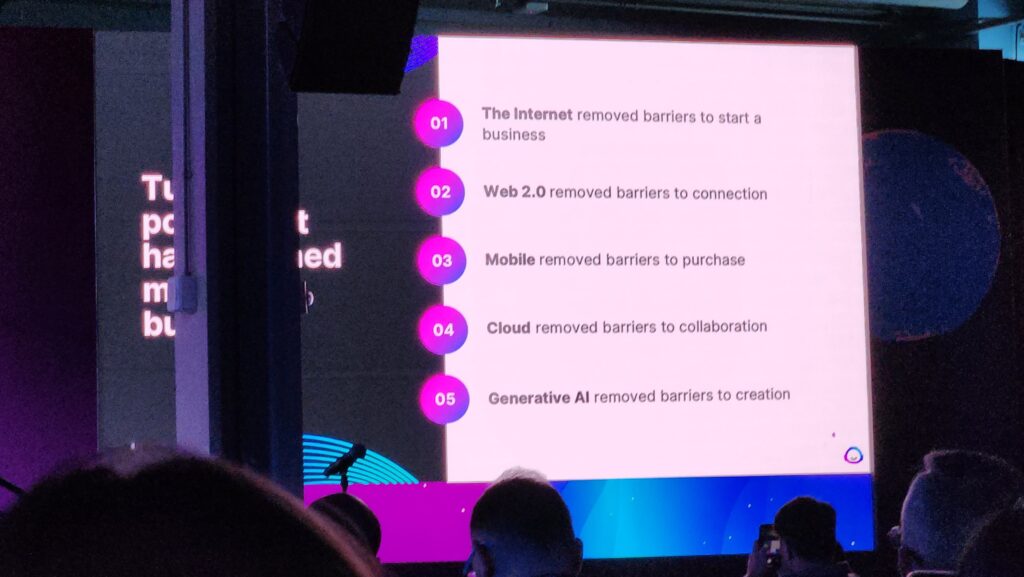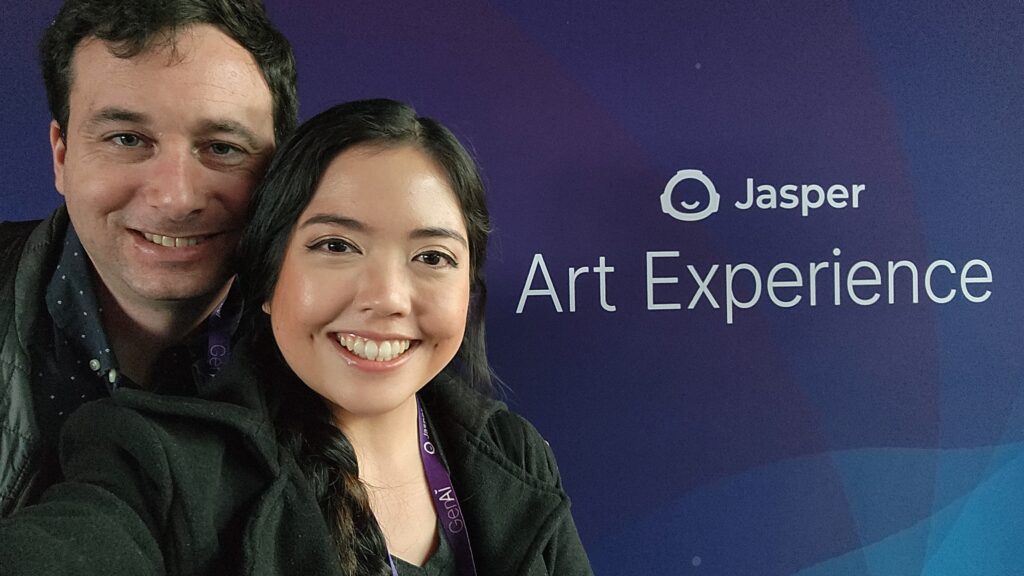
Generative AI has taken the world by storm, and every industry (including property management and real estate) is scrambling to figure out how to capitalize on this. It’s a brave new world, and those who can make the most of it will be the ones who come out on top in the end.

Marie Tepman’s Fourandhalf Nails and GenAI Conference Badge
This is exactly why I attended the GenAI Conference in San Francisco hosted by Jasper on February 14, 2023. It was the very first conference ever about Generative AI, and it brought together the leading minds in the field such as the CEO of Stability AI, Emad Mostaque, and the Chief Scientist of GPT-3, Dario Amodei.
Top caliber panelists and speakers included the former CEO of GitHub (Nat Friedman), CEO of Jasper (Dave Rogenmoser), and VP of Product and Partnerships at OpenAI (Peter Welinder).
At this conference, I learned a lot about how this technology works, where it is headed, as well as its impact on marketing any business. But since I specialize in property management marketing, the focus of this blog is how to leverage my learnings about Generative AI for property managers. Here are some of my key takeaways:
Traditional AI vs. Generative AI
 Before this conference, I was under the impression that AI was AI. But it turns out, I was wrong. We’ve all heard of the “AI will take over the world” trope, which has been the subject of many sci-fi movies. It’s not exactly new.
Before this conference, I was under the impression that AI was AI. But it turns out, I was wrong. We’ve all heard of the “AI will take over the world” trope, which has been the subject of many sci-fi movies. It’s not exactly new.
According to the article “The History of Artificial Intelligence” published on the Harvard website, Artificial Intelligence (AI) has been around since the mid-1950s. Alan Turning initially explored the possibility of using machines to solve complex problems, but the term “artificial intelligence” wasn’t used until the creation of Logic Theorist, the first AI program, five years later.
Fast forward to the late 1990s, and AI was able to beat Russian chess grandmaster Gary Kasparov in– you guessed it, the game of chess. This type of AI is referred to as traditional AI.
What we refer to as traditional AI, is designed around problem-solving. It takes complex data sets and uses them to make decisions or predictions.
Generative AI, on the other hand, is designed to create content. Whether it be articles, emails or even text messages, generative AI can generate responses based on what it has ‘learned’ from data. So while traditional AI was used mainly for problem-solving tasks, generative AI can be leveraged for creative activities.
How Generative AI Works
As its name suggests, Generative AI works by taking existing data and using it to generate new information. It does this by analyzing existing pieces of content and then generating new ideas based on the patterns it finds. This technology can use both structured and unstructured data from a variety of sources, including images, audio files, text documents, etc.
One of the most innovative features of Generative AI is its ability to self-correct itself. This means it can adapt quickly to changing requirements and new data sets. It can also produce more accurate results than traditional AI.
The most popular Generative AI interface out there is ChatGPT. It’s an AI language model that was designed to mimic the way humans converse.
Why is ChatGPT So Popular?
Although the developers of Generative AI tools can tell you how they work, what’s fascinating is even they don’t fully understand what their tools are capable of. As Peter Welinder from OpenAI said during a panel, they launched their tool with absolutely no expectations. They were shocked by the mass reaction and adoption of ChatGPT. His team had no idea that their chatbot could even code in Python until users started talking about it.
So far, users have reported ChatGPT being able to write poetry or music, make predictions based on data, and generate text that can be used in business and research. The thing that makes this chatbot so revolutionary is its user-friendliness and its ability to understand context within the same conversation. These qualities (and the fact that you can get it for free) have made it accessible to literally anyone — catapulting generative AI into the mainstream.
AI to Streamline Content Creation for Property Management Businesses
Generative AI is already being used to create content in every industry you can think of. The industries represented at the conference were staggering.
There have been conversations within the property management community about how AI tools are poised to disrupt the property management marketing space. My professional opinion is that they have already disrupted the space.
To understand exactly how it has done so, let’s break it down to the different types of content that property management businesses need to generate regularly:
1. Property Listings Content
 Generative AI can be used to create property listings quickly and efficiently. It can take existing data points such as location, price, square footage, amenities, etc., and generate content for each listing automatically. This saves time by eliminating the need for manual research, writing and editing.
Generative AI can be used to create property listings quickly and efficiently. It can take existing data points such as location, price, square footage, amenities, etc., and generate content for each listing automatically. This saves time by eliminating the need for manual research, writing and editing.
Earlier this month, the Triple Win Podcast by Second Nature put together a panel discussion about AI’s role in property management. During that panel, self-proclaimed property management automation ninja, Wolfgang Croskey, explained how he uses ChatGPT for property marketing.
Before ChatGPT, his team could spend 30 to 45 minutes writing a rental property description that was deemed “really good.” But now, he is using Zapier to push relevant information from his CRM onto ChatGPT, and the AI then writes advertising copy for each rental listing.
He also said that doing this was a no-brainer because property descriptions are necessary, but not impactful. Think about it — when was the last time someone wanted to rent or buy a home because of the listing description you wrote?
2. Social Media and Video Content
 Generative AI can also be a great ally for creating social media and video content. The same tools we mentioned above (ChatGPT, Jasper AI, etc.) can help you easily craft captions for your visuals or come up with funny puns to make your followers laugh.
Generative AI can also be a great ally for creating social media and video content. The same tools we mentioned above (ChatGPT, Jasper AI, etc.) can help you easily craft captions for your visuals or come up with funny puns to make your followers laugh.
The first speaker at the GenAI Conference was a very popular content creator and internet personality named Zach King. He shared exactly how he and his team utilize AI tools to spark new ideas, improve their content briefs, and get to the execution phase so much faster.
That talk inspired me to utilize AI more in Fourandhalf’s content creation process. As a result, we were able to slash our internal video creation timeline in half! And even better, we’re working on creative ways to bring those efficiencies to property management companies to help them get more visibility online.
3. Email Marketing Content and Google Ads Copy
 Utilizing marketing automation and pay-per-click advertising such as Google Ads are good for business, but coming up with the actual content can be daunting and time-consuming.
Utilizing marketing automation and pay-per-click advertising such as Google Ads are good for business, but coming up with the actual content can be daunting and time-consuming.
Generative AI can come to the rescue in this case, as well. For example, ChatGPT can help you create email or ad copy quickly and easily – all it takes is a few clicks. One of the panelists during the conference even shared that he uses ChatGPT to draft emails for him. Although he wouldn’t trust it enough to simply copy-paste directly from the chatbot, he said that he can usually get something that was 90% good enough.
However, writing the copy is only part of the battle. You still have to set up your campaigns and maintain them. Read our blog about what it takes to maintain a Google Ads campaign.
4. Lead Magnets
 AI tools can help you create interesting lead magnets such as ebooks and guides. For example, ChatGPT can help you generate ideas for topics to focus on in a lead magnet or even provide content summaries that you can use.
AI tools can help you create interesting lead magnets such as ebooks and guides. For example, ChatGPT can help you generate ideas for topics to focus on in a lead magnet or even provide content summaries that you can use.
Just note that when Fourandhalf tested how well ChatGPT can write about property management, it skewed more towards tenant-facing content rather than owner-facing content. So if you are trying to create lead magnets to attract owners rather than tenants, make sure you use the right prompts to guide the algorithm.
5. Online Reputation Management
 I know, I know. This one sticks out like a sore thumb. How is online reputation related to content creation? I’m glad you asked.
I know, I know. This one sticks out like a sore thumb. How is online reputation related to content creation? I’m glad you asked.
Think of your business’s online presence as a stage and everything that can be attributed to it as the content that you put on that stage. This includes the online reviews and your clever responses that are publicly available for everyone to see. Remember, potential renters and property owners are watching and consuming all of this content during the Consideration Phase of their buyer’s journey. So, let’s give them a show they won’t forget – one that makes them want to work with you.
AI tools can help you quickly and easily craft review request emails, as well as draft review responses that are professional and custom.
6. Property Management Website Copy and Blogs
 Generative AI can also be used to write website content for a property management business in less time than it would traditionally take. We’ve seen several property managers online who are vocal about their use of AI when writing copy for their website or blog pages. The most popular tools of choice are ChatGPT and Jasper AI.
Generative AI can also be used to write website content for a property management business in less time than it would traditionally take. We’ve seen several property managers online who are vocal about their use of AI when writing copy for their website or blog pages. The most popular tools of choice are ChatGPT and Jasper AI.
But a word of caution: even though Google does not discriminate against AI-generated content, it does have very high standards on what it deems worthy of indexing on relevant Search Engine Results Pages (SERPs). AI can help you write faster, but you have to pay attention to quality if you want your website copy and your blogs to help with Search Engine Optimization (SEO).

Screenshot of Danny Sullivan Tweet about Google’s Stance on AI generated content
I recently wrote a blog on the Fourandhalf website about this very topic, so be sure to read the post titled “Google Algorithm Updates: How they Impact Property Management Marketing“.
And speaking of Google and SEO, the next section is about to blow your mind.
Bing Chatbot and Google’s BARD
BING has already integrated ChatGPT, and Google is working on a similar integration for Google Search that they are calling BARD. What does this have to do with SEO? Well, everything.
It’s really about supply and demand. As of February 2023, the majority of online searches are still done by typing a query on a search bar and then getting a whole page filled with links, images, videos, etc. This page is called a Search Engine Results Page or SERP. It’s riddled with ads, and the user essentially has to pick which pieces of content to consume and which links to click.
But once the two biggest search engines shift their platforms into chat-first, it would change the way humans get their queries answered. Users just need to type in a question, and the chatbot spits out a short, concise answer. No ads, no having to sift through several links and articles to find a source you deem credible. The chatbot will basically analyze and summarize all the relevant articles and deliver that summary to the user.
This means that the way we’ve been optimizing for the current search engines, may not be as relevant in the world of Chat Search. SEO as we know it would be upended.
GPT-4 is Right Around the Corner
As amazing as ChatGPT is right now, it’s about to get better. It’s currently based on the GPT-3 language model, but its developers at OpenAI are already working on GPT-4. This next-level model is scheduled to be released sometime in 2023, so the next several months will be a roller coaster ride for everyone.
Nobody knows for sure what it will be capable of, but it will certainly be lightyears better than what we are seeing now.
Human vs. AI: Who Will Win the Marketing Game?

Turning Points Initiated by Technology
This question has haunted me for a while. Are human marketers on the fast lane to becoming obsolete? Surprisingly, attending the GenAI Conference gave me the answer to this question along with some peace of mind.
Let me explain.
The closing keynote speaker was Meghan Keany Anderson, the VP of Marketing for Jasper AI. Her talk was all about this unique time when technology is forcing a turning point in marketing. She said that in the golden age of advertising, big budgets won. In the age of content marketing, higher capacity won. But in the age of Generative AI, the best ideas will win. Because when anyone can create content using AI, unique ideas will be the only way to break through the clutter and noise.
She went on to say that AI relies on patterns and it’s not great at finding new territory. On the other hand, humans are great at finding new angles to things we’ve seen a million times before. When you combine the power of AI and the originality of people, that is where we can come up with truly great things. She urged the marketers in the room to look at AI as a tool that doesn’t come to life until it’s in our hands.
That resonated with me deeply. She made me realize that I shouldn’t look at AI as an adversary. If the world of marketing was the Kentucky Derby: we can’t win the Derby by fighting with the horses, and the horses can’t win without their riders either.
At the end of her talk, I had another realization — Jasper AI has a whole marketing team. The very tool that most people think will replace marketers, has a whole team of humans doing their marketing. That thought made me smile and gave me the peace of mind I needed.
I walked out of the conference hopeful and excited about this turning point in marketing. It’s a time when the best ideas will win and our creativity and ingenuity will be rewarded. It’s a unique time to be alive, and I’m looking forward to seeing what amazing things we can come up with in this new era of Generative AI.

Marie and Ziv at Jasper Art Experience Sign

